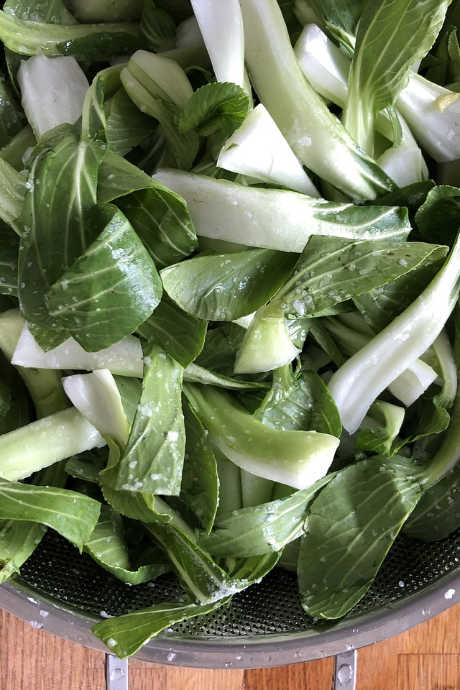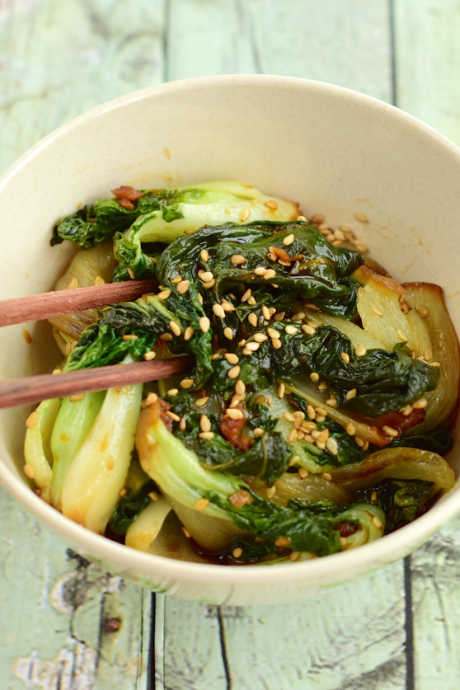Stock Up on Bok Choy
Posted by Julie on Jun 27th 2019
We love how broad the selection of leafy greens has become, even at big box supermarkets. Gone are the days of a simple choice between spinach and iceberg lettuce. Now you can mix it up with kale, endive, arugula, Swiss chard, and a whole range of lettuce varieties. One of our favorites is bok choy because it’s so versatile. In this post, we’ll share more details about this Chinese vegetable and how you can prepare it yourself.
Basics of Bok Choy
Bok choy is part of the cabbage family. It’s a cruciferous vegetable like radishes, broccoli, and cauliflower. You may find both bok choy and baby bok choy at the grocery. Similar to baby kale and baby spinach, baby bok choy is a younger, more tender version.
Bok choy has crisp white stalks, and dark leaves like broccoli. Baby bok choy also has crisp stalks, but they’re light green instead of white. The leaves of baby bok choy are smoother and more tender than mature bok choy.
Like other leafy greens, bok choy is known for being packed with vitamins and minerals. It offers vitamin C, beta carotene, iron, calcium, and folate, plus a good amount of fiber. Raw bok choy does contain an enzyme that can impair thyroid function, but it’s only a concern if you eat multiple pounds of bok choy on a daily basis. No matter how delicious bok choy may be, we’re confident most people won’t eat that much of it.
Purchasing and Prep Tips for Bok Choy
Look for bok choy with firm stalks and crisp greens. Avoid bunches that are blemished, rubbery, or wilted, especially if you plan to serve them raw. Even when cooked, bok choy stalks will retain some crunch. The leaves will release moisture and shrink, similar to spinach.

You can leave your bok choy in a plastic produce bag or paper bag in your refrigerator for three to five days. Once you’re ready to use it, wash it thoroughly. Chop off the bottom and remove the stalks to wash individually. Cooks Illustrated advocates for slicing baby bok choy in half, no matter how small the bulbs may be. It’s nearly impossible to get all the dirt out otherwise.
Ways to Eat Bok Choy
As we mentioned above, bok choy is wonderfully versatile. Eat it raw in salads, or with dip as part of a veggie tray. Stir fry it, saute it, braise it, or roast it -- bok choy works with a variety of cooking methods. Below, we’ll offer three options for you to try.
Raw Bok Choy
Don’t be concerned about eating bok choy raw. This recipe from Culinary Hill calls for five or six bulbs of baby bok choy, and it makes eight servings. Start by mixing the dressing ingredients: olive oil, vinegar, soy sauce, brown sugar, and sesame seeds. Whisk in a bowl or shake in a jar, and then let the flavors meld as you prepare the rest of the salad.
Like any good salad, this one includes some texture to complement to bok choy greens. Crumble ramen noodles until no more large chunks remain. Then saute them in a skillet with oil. Add some almonds too, either sliced or slivered depending on your preference. Wash and chop the bok choy before combining it with the crunchy noodles and almonds. Then toss everything with the dressing. This salad travels well, so keep it in mind for gatherings and picnics.
Sauteed Bok Choy
We can hardly wait to try this recipe from Steamy Kitchen because of the logic behind the cooking process. Instead of heating up the wok and the oil before adding ginger and garlic, Jaden turns the order on its head. Add the oil to a cold pan, add the garlic and ginger next, and then turn on the burner. The reason for this approach is to give those aromatics more time in the oil without overcooking them. Plus, the bok choy leaves and stalks don’t need much time in the oil, so it isn’t essential to heat it up immediately.

After you’ve quickly tossed the leaves and stalks in the oil, add a bit of liquid to the pan and cover it. You can use water, broth, Asian cooking wine, or any combination of these. The bok choy will steam through and be ready to serve in only a few minutes. Jaden recommends using tongs to toss and turn the bok choy, rather than a spatula.
Roasted Bok Choy
Finally, we’re impressed by this recipe from Plated in which bok choy and salmon roast together on a baking sheet. Pile them both on a bed of jasmine rice, then drizzle a jalapeno-lime glaze over the top. The glaze includes lime juice, diced jalapeno, scallions, garlic, soy sauce, ginger and honey. Of course, you can order all the ingredients in perfectly-sized quantities from Plated, but all of them are easy enough to find at the supermarket.

